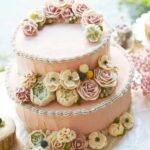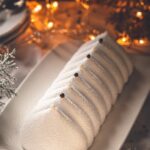When it comes to cake decorating, the right icing can make all the difference in creating a stunning and visually appealing masterpiece. In this article, we will explore the art of making thick icing for cake decorating. Whether you’re a seasoned baker looking to elevate your skills or a novice wanting to try your hand at creating beautifully decorated cakes, mastering the technique of thick icing is essential.
Thick icing plays a crucial role in cake decorating as it provides structure and stability to intricate designs and decorations. From piping intricate borders to sculpting delicate flowers, having the right consistency of icing is key to achieving professional-looking results. Whether you prefer the creamy richness of buttercream or the smooth finish of royal icing, mastering the art of making thick icing will take your cake decorating skills to the next level.
In this comprehensive guide, we will delve into the different types of icing commonly used in cake decorating, namely buttercream and royal icing. We will also discuss the essential ingredients needed to make thick icing, as well as provide a step-by-step guide on achieving the perfect consistency.
Additionally, we will explore tips for coloring and flavoring options for thick icing, troubleshooting common issues that may arise, and creative ways to decorate cakes using this versatile medium. So roll up your sleeves, grab your piping bags, and let’s dive into the world of thick icing for cake decorating.
Types of Icing
When it comes to cake decorating, choosing the right type of icing is essential for achieving the desired look and texture. Two popular options for thick icing are buttercream and royal icing. Each has its own unique characteristics and uses in the world of cake decoration.
Buttercream
Buttercream is a versatile and creamy icing that is perfect for creating smooth finishes or intricate designs on cakes. It is made by creaming together butter, powdered sugar, and flavorings such as vanilla extract. Buttercream is known for its rich flavor and soft texture, making it ideal for spreading, piping, and shaping on cakes of all sizes.
Royal Icing
On the other hand, royal icing is a hard-drying icing that becomes crisp once set. It is made from a mixture of confectioners’ sugar, egg whites or meringue powder, and water. Royal icing is commonly used for intricate decorations like flowers, lacework, and lettering on cakes and cookies. Its ability to dry quickly makes it a favorite for gingerbread house construction and other projects requiring structural stability.
Understanding the differences between buttercream and royal icing can help you decide which type of thick icing to use based on your specific design needs. Experimenting with both can give you a better idea of how each one performs in different decorating situations. Whichever you choose, mastering the art of making thick icing will elevate your cake decorating skills to new heights.
Ingredients Needed to Make Thick Icing
When it comes to cake decorating, having the right type of icing is crucial for creating stunning designs and textures on your cakes. One key element in achieving these intricate decorations is using thick icing. Whether you prefer buttercream or royal icing, having a thick consistency allows for greater control and precision when piping or spreading the icing onto your cake.
To make thick icing for cake decorating, you will need a few key ingredients that help in achieving the desired texture and stability. Below is a list of essential ingredients needed to create thick icing:
- Confectioners’ sugar (powdered sugar): This finely ground sugar is essential for creating a smooth texture in your icing.
- Butter or shortening: To add richness and creaminess to your icing while helping it hold its shape.
- Milk or heavy cream: Liquid ingredients that are necessary for thinning out the icing to your desired consistency.
- Vanilla extract or other flavorings: For adding flavor to your icing and enhancing the overall taste of your cake.
In addition to these basic ingredients, you may also choose to add cornstarch or meringue powder to improve the stability of your thick icing. These additives can help prevent your decorations from losing their shape or melting in warmer temperatures. Experiment with different combinations of ingredients to find the perfect recipe that works best for your specific cake decorating needs.
Step-by-Step Guide on Making Thick Icing
Making thick icing for cake decorating is a crucial step in achieving beautiful and professional-looking cakes. Whether you’re piping intricate designs or creating smooth finishes, having the right consistency of icing can make all the difference. Here is a step-by-step guide on how to make thick icing for your cake decorating needs.
Gather Your Ingredients
Before you start making your thick icing, ensure you have all the necessary ingredients ready. You will need confectioners’ sugar (also known as powdered sugar), unsalted butter, vanilla extract or any other desired flavoring, and a liquid such as milk or heavy cream.
Mixing the Ingredients
Start by creaming the softened butter in a mixing bowl until it is smooth. Gradually add in the confectioners’ sugar, one cup at a time, while mixing on low speed. Add in your desired flavoring and continue to mix until well combined. If the mixture seems too thick, slowly incorporate small amounts of your chosen liquid until you reach the desired consistency.
Testing and Adjusting
Once your icing has reached the desired thickness, test it by lifting your spatula. The icing should form stiff peaks and hold its shape well. If it’s too thin, add more powdered sugar; if it’s too thick, add more liquid. Keep adjusting until you achieve that perfect thick texture that is ideal for piping decorations on cakes.
By following these steps, you can create a beautifully thick icing that is perfect for all your cake decorating needs. Experiment with different colors and flavors to unleash your creativity and bring your cake designs to life.
Tips for Achieving the Perfect Consistency
Creating the perfect consistency for your icing is crucial when it comes to cake decorating. Whether you are using buttercream or royal icing, having the right texture can make all the difference in achieving a professional-looking finish. So, how to make thick icing for cake decorating? Here are some tips to help you achieve the perfect consistency every time.
First and foremost, one of the most important factors in making thick icing is controlling the amount of liquid you add to your mixture. When adding liquid, such as milk or water, do so gradually and mix well in between additions. This will allow you to have better control over the thickness of your icing and prevent it from becoming too runny.
Another tip for achieving the perfect consistency is to adjust the amount of confectioners’ sugar in your recipe. If your icing is too thin, add more sugar until you reach the desired thickness.
On the other hand, if your icing is too thick, you can thin it out by adding a small amount of liquid or flavoring extract. It may take some practice to find the right balance, but don’t be afraid to experiment until you get it just right.
Lastly, consider the temperature of your ingredients when making thick icing. Butter or shortening should be at room temperature before use, as this will help create a smoother texture.
On the other hand, if your kitchen is too warm and your icing becomes too thin, you can try chilling it for a few minutes before using it on your cake. By keeping these tips in mind and practicing with different recipes and techniques, you’ll soon master the art of making thick icing for cake decorating.
| Tips for Achieving Perfect Consistency | How to Make Thick Icing for Cake Decorating |
|---|---|
| Control liquid additions and mix well | Controlling that amount of liquid added gradually helps in achieving optimal thickness. |
| Adjust confectioners’ sugar | Add more if too thin and add liquid if too thick; experiment till achieving ideal balance. |
| Maintain ingredient temperatures | Ensure butter or shortening are room temperature; chill if needed due to warm environment. |
Coloring and Flavoring Options for Thick Icing
When it comes to cake decorating, the color and flavor of the icing play a crucial role in creating a visually appealing and delicious end product. Whether you are making buttercream or royal icing, there are various options available to customize your thick icing to suit your preferences and the theme of your cake.
Here are some ideas for coloring your thick icing:
- Gel food coloring: Gel-based food coloring is recommended for tinting icing as it does not alter the consistency of the mixture.
- Natural food dyes: Opt for natural food dyes made from ingredients like beet juice, spinach powder, or turmeric for a healthier alternative.
- Airbrush colors: For a more advanced technique, consider using airbrush colors to achieve vibrant shades and gradient effects on your cakes.
In addition to color, flavor plays a significant role in enhancing the taste of your cake. Here are some options for flavoring your thick icing:
- Vanilla extract: A classic choice that pairs well with most cake flavors.
- Almond extract: Adds a subtle nutty flavor that complements white or yellow cakes beautifully.
- Citrus zest: Incorporate lemon, orange, or lime zest for a refreshing citrus twist to your icing.
Experimenting with different colors and flavors can take your cake decorating skills to the next level. Don’t be afraid to get creative and try out unique combinations to make your cakes stand out at any occasion.
Troubleshooting Common Issues With Thick Icing
When it comes to cake decorating, having the right consistency of icing is crucial. Thick icing can provide stability for intricate designs and shapes on a cake, but sometimes issues can arise during the process. Understanding common problems and how to troubleshoot them can save you time and frustration when working with thick icing.
One common issue that bakers face when making thick icing for cake decorating is air bubbles. These pesky bubbles can create an uneven surface on your cake or cause the icing to break apart. To prevent this problem, make sure to gently tap or stir the icing after mixing to release any trapped air bubbles. Additionally, using a spatula or paddle attachment on a mixer instead of a whisk attachment can help minimize the introduction of air into the icing.
Another common problem with thick icing is graininess or a gritty texture. This can occur if the ingredients are not properly mixed or if the sugar particles have not dissolved completely. To fix this issue, try adding a small amount of warm water or milk to the icing and mix well until smooth. If the grittiness persists, you may need to strain the icing through a fine sieve to remove any clumps.
Lastly, cracking or crusting of thick icing can be frustrating when trying to achieve a smooth finish on a cake. To avoid this issue, make sure to cover your bowl of icing with a damp cloth while working to prevent it from drying out too quickly.
Additionally, adding a small amount of corn syrup or glycerin to your mixture can help keep the icing pliable and prevent it from hardening too fast. By troubleshooting these common issues with thick icing, you’ll be able to create beautiful and professional-looking cakes for any occasion.
Creative Ways to Decorate Cakes Using Thick Icing
One of the most exciting parts of cake decorating is getting creative with different designs and techniques using thick icing. Whether you’re a beginner or a seasoned baker, there are endless possibilities when it comes to decorating cakes with thick icing. From simple swirls and borders to intricate flowers and figures, thick icing can elevate your cakes to the next level.
When it comes to creating unique decorations with thick icing, piping is key. Piping involves using a pastry bag and various tips to create different shapes and designs on the cake’s surface. Some popular piping techniques include rosettes, shells, leaves, and scrolls. Experimenting with different piping tips and techniques can help you discover your own personal style and creativity when it comes to cake decorating.
Another fun way to decorate cakes using thick icing is by incorporating textures and patterns. You can achieve this by using different tools such as combs, spatulas, or even stencils. Textured buttercream can add depth and dimension to your cake decorations, making them visually appealing and eye-catching. Don’t be afraid to try out new tools and techniques – you never know what amazing creations you might come up with.
| Piping Techniques | Texture Tools |
|---|---|
| Rosettes | Spatulas |
| Shells | Combs |
| Leaves | Stencils |
Conclusion
In conclusion, mastering the art of making thick icing for cake decorating can truly elevate your creations to a whole new level. Whether you choose buttercream or royal icing, understanding the right ingredients and techniques is essential. By following a step-by-step guide and incorporating tips for achieving the perfect consistency, you can ensure that your cakes not only look beautiful but taste delicious as well.
Experimenting with different coloring and flavoring options can further enhance your cake decorating skills and allow you to unleash your creativity. Remember that practice makes perfect, so don’t be afraid to try out new techniques and designs using thick icing. By troubleshooting common issues that may arise along the way, you’ll become more confident in your abilities and be able to tackle any challenges that come your way.
In the end, the key to successful cake decorating lies in patience, practice, and a passion for creating edible works of art. So go ahead and have fun exploring the world of thick icing – who knows, you might just discover a new favorite hobby or even start your own cake decorating business. The possibilities are endless when you have the knowledge of how to make thick icing for cake decorating at your fingertips.
Frequently Asked Questions
How Do You Make Icing Thicker for Decorating?
To make icing thicker for decorating, you can add more powdered sugar until you reach the desired consistency. Another option is to mix in a small amount of cornstarch or cream cheese to thicken the icing.
What Is the Best Icing for Cake Decorating?
The best icing for cake decorating depends on personal preference and the type of design you’re creating. Buttercream icing is popular for its smooth texture and ability to hold intricate designs. Royal icing is another great option for creating detailed decorations.
What Is the Thick Icing on a Cake Called?
The thick icing on a cake is typically referred to as frosting or buttercream icing. This type of icing is often used not only for decorating purposes but also to add flavor and moisture to the cake layers. Frosting can come in various consistencies, from thin glazes to thick, fluffy textures perfect for piping decorations onto cakes.

Welcome to our cake decorating blog! My name is Destiny Flores, and I am the proud owner of a cake decorating business named Cake Karma. Our mission is to provide delicious, beautiful cakes for all occasions. We specialize in creating custom cakes that are tailored specifically to each customer’s individual needs and tastes.





